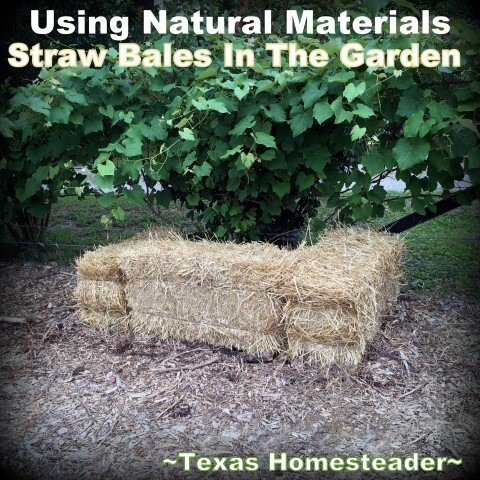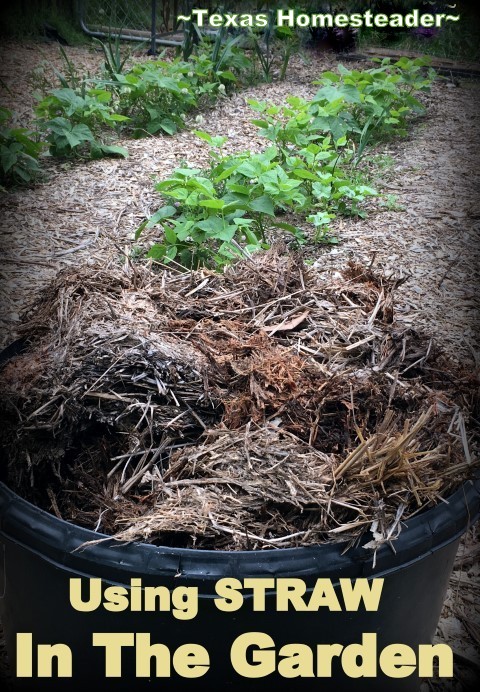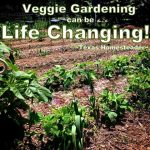by Texas Homesteader ~
I like to use natural materials in my garden. Things such as straw, wood chips Dry Leaves or even grass mulch after RancherMan mows the lawn and bags the cut grass. (be sure to let that freshly-cut grass cure a bit before adding it close to your plants or it could burn them)
For instance, I have a grapevine that I’ve surrounded with three bales of straw. That straw serves a dual purpose. Its initial purpose is to protect my garden from encroaching bermuda grass.
You see, I have a section of my garden that holds my Concord Grapevine. I’ve trained it to grow along the fence. It’s LOADED with grapes and I Harvest Many Grapes from it each year.
But I’ve also vowed to keep the Bermuda grass from creeping into my garden. So all the walkways in the garden plus a wide perimeter swath is mulched with free wood chips.
But the grapevine is right at the fence line. So to keep bermuda from creeping in around the grapevine I surrounded it with those 3 bales of wheat straw. The purpose was just to deny sneaky Bermuda the sunlight as it attempts to grow beneath the bales to get into my garden.
Permission: DENIED!
Straw Bales For Grass Barrier
Off to the feed store we went and I picked up three brand spankin’ new bales of wheat straw. They’re lightweight and they’re cheap. And I love that they’re a natural material too. These will be perfect.
When we got home I raked away all the wood mulch that surrounded my grapevine in preparation for these straw bales to be positioned.
Then I laid some flattened paper feed bags on the ground & topped it with the three new straw bales. Looks great! These bales should serve their grass-barrier purpose for about 2-3 years.
Important New Purpose For Old Straw
But after a few years those straw bales start to deteriorate. That’s when I’ll need to replace them. But those old deteriorated bales’ useful life isn’t over, oh no! Now they’ll go to their second use: mulch.
Here in Texas it’s typically very hot and dry during our summertime months. So I’m careful to mulch our garden heavily. Mulching helps the plants in many ways.
It not only conserves that precious moisture, but it also moderates soil temps. I like to mulch with natural materials whenever possible. A typical gardening year will see me mulching with grass clippings, leaves or spent hay.
Some of the bales I can use right now. So I took handfuls of that spent straw and placed it liberally around my veggies to protect my veggie plants.
As this straw decomposes it will just be stirred into the garden soil next year when I plant. That organic matter will continue to improve my precious soil.
So that straw actually served double duty – protecting my garden from Bermuda grass for several years. Then preserving moisture & helping my garden grow.
But I wanted to store some of it to use later when the garden needs it most – the hot summer months. So I stuffed much of the straw from the falling-apart bales into large buckets to store it for later too.
I snapped the lids on top of those buckets of spent straw to protect the contents from rain. Then I set those lidded tubs along the perimeter of the garden to await the stored straw’s use.
As the temps heat up I’ll need to reapply that straw mulch to my planting rows. I know it’ll be right here when I need it. #UseWhatchaGot!
~TxH~
My Favorite Garden Hacks
Garden Planning
- Easy Garden Planting Plan Spreadsheet
- Prepare Now! Late-Winter Garden Checklist
- How To Make Your Own Garden Soil
- Prepare Your Garden For Spring Planting
Seed Planting
- Planting Seeds In A Milk Jug Mini-Greenhouse
- Planting A Clear Tote As An Indoor Greenhouse
- Repurposed Cardboard Seed-Starting Pots
Soil Health
- Easy Compost For A Healthy Garden
- How Leaves Benefit Your Garden
- Using Manure In Your Compost & Garden
Garden Styles
- How & Why To Use Raised Beds In Your Garden
- 3-Sister’s Garden – The Original Companion Planting
- Planting A Large Galvanized Trough
- Where I Found The BEST Raised Bed!
- Planting A Blueberry Bush In Rustic Galvanized Tub
- Creating A Vibrant Pollinator Garden
Garden Plants/Harvest
- Stevia – Growing Your Own Sweetener!
- My Simple, Zero-Waste Herb Drying Setup
- The Lazy Gardener’s Plant List – Plant Once, Eat For Years!
- How To Tell When Watermelon Is Ripe
- Luffa A Surprising Zucchini Substitute!
- How To Plant & Grow The Best Tomatoes
Water/Irrigation/Drought
- Keeping Potted Plants Watered
- Repurposing A Coffee Can For Deep-Soak Watering
- 3 Rainwater Collection Systems We Use
- Cheap (or FREE) Wood Mulch For The Garden
- Using Vining Plants For Living Mulch
- Surprising Use For Empty Clay Pots In The Garden
Weed Control
Garden Tips
- How To Save Outdoor Plants Even During A Hard Freeze
- Growing A Sustainable Garden: Eco-Friendly Practices
- Tricking Birds AWAY From Your Strawberry Plants
- Protecting Tender Seedlings From Wind
- Homestead Hack: Remember Where You Planted Seeds
- How I Use EcoBricks In The Garden
MORE Gardening Posts
References:
Find Your 2023 Updated USDA Plant Hardiness Zone
Texas Master Gardener’s Companion Planting – Plant Friend & Foe
C’mon by & sit a spell! Come hang out at our Facebook Page. It’s like sitting in a front porch rocker with a glass of cold iced tea. Lots of good folks sharing! You can also follow along on Pinterest, on Twitter or on Instagram.
If you’d like to receive an email each time a new blog post goes live it’s EASY to subscribe to our blog








The ol’ debate: hay vs. straw
Doesn’t hay have seeds in it and prone to cause sprouting of them in the garden when using it for mulch? Thanks.
Although this article is about using straw in the garden, I’ve used both hay and straw. In using hay there are a few seeds but it’s never been problematic. The hay mulch is thick enough that it’s effortless to pull any volunteers out. And spent hay from around the hay rings is free so I don’t have to buy it year after year like I do bales of straw. So for us, either straw or hay works fine in our garden but hay actually gets used more often because I know our hay producer (and the hay’s not been sprayed with herbicide) and it’s a previously wasted resource that costs us nothing. Happy gardening! ~TxH~
We use hay in our garden for the beds and wood chips for the paths. It keeps all but the most pesky, vine-like, weeds out of the garden. I never thought about putting a hole bale somewhere.
The wood chips in he paths has been very helpful to me too Katy. But when that rainwater tap turns off about this time each year, I really like to have a thick layer of mulch protecting my plants. This straw worked so well for me, because it was its second purchase after protecting the grapes. Use Whatcha Got! ~TxH~
I use hay in my garden. Hay is $11 a bale and straw is much more than that. When I rake up oak leaves, and cut grass. Anything works.
I use whatever natural materials I’ve got when I’m mulching my garden too Charlene. Typical mulch for me is grass clippings, leaves and spent hay. But this straw was leftover from deteriorated straw bales that had been used for another purpose & was no longer fit for that purpose. I sure didn’t want to waste it, so it made a perfect mulch too. Double Duty! I’m a big fan of #UseWhatchaGot! ~TxH~
Wow – talk about getting your money’s worth out something! What a great and simple idea to protect the grapes, too. Thanks for sharing.
Double duty for sure, Monica. 🙂 ~TxH~